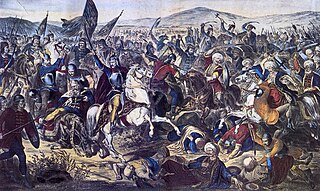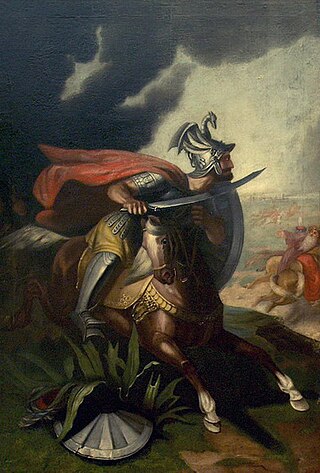Related Research Articles

Murad II was twice the sultan of the Ottoman Empire from 1421 to 1444 and from 1446 to 1451.

The Ottoman Empire, historically and colloquially known as the Turkish Empire, was an imperial realm that spanned much of Southeast Europe, West Asia, and North Africa from the 14th to early 20th centuries; it also controlled parts of southeastern Central Europe between the early 16th and early 18th centuries.

Osman I or Osman Ghazi was the founder of the Ottoman Empire. While initially a small Turkoman principality during Osman's lifetime, his beylik transformed into a world empire in the centuries after his death. It existed until shortly after the end of World War I.

The Battle of Kosovo took place on 15 June 1389 between an army led by the Serbian Prince Lazar Hrebeljanović and an invading army of the Ottoman Empire under the command of Sultan Murad Hüdavendigâr.

Miloš Obilić was a legendary Serbian knight who is reputed to have been in the service of Prince Lazar during the Ottoman invasion of Serbia in the late 14th century. He is not mentioned in contemporary sources, but features prominently in later accounts of the 1389 Battle of Kosovo as the assassin of Sultan Murad. Although the assassin remains anonymous in sources until the late 15th century, the dissemination of the story of Murad's assassination in Florentine, Serbian, Ottoman and Greek sources suggests that versions of it circulated widely across the Balkans within half a century of the event.

Albanian culture or the culture of Albanians is a term that embodies the artistic, culinary, literary, musical, political and social elements that are representative of Albanians. Albanian culture has been considerably shaped by the geography and history of Albania, Kosovo, parts of Montenegro, parts of North Macedonia, and parts of Northern Greece, traditional homeland of Albanians. It grew from that of the Paleo-Balkan cultures, including Proto-Albanian, Illyrian, Thracian, Dacian, with their pagan beliefs and specific way of life in the wooded areas of far Southern Europe. Albanian culture has also been influenced by the Ancient Greeks, Romans, Byzantines and Ottomans.

Romani music is the music of the Romani people who have their origins in northern India but today live mostly in Europe.

Ertuğrul or Ertuğrul Ghazi was a 13th-century bey, who was the father of Osman I. Little is known about Ertuğrul's life. According to Ottoman tradition, he was the son of Suleyman Shah, the leader of the Kayı tribe of the Oghuz Turks. These Turkomans fled from western Central Asia to Anatolia to escape the Mongol conquests, but he may instead have been the son of Gündüz Alp. According to this legend, after the death of his father, Ertuğrul and his followers entered the service of the Sultanate of Rum, for which he was rewarded with dominion over the town of Söğüt on the frontier with the Byzantine Empire. This set off the chain of events that would ultimately lead to the founding of the Ottoman Empire.

The Ottoman dynasty consisted of the members of the imperial House of Osman, also known as the Ottomans. According to Ottoman tradition, the family originated from the Kayı tribe branch of the Oghuz Turks, under Osman I in northwestern Anatolia in the district of Bilecik, Söğüt. The Ottoman dynasty, named after Osman I, ruled the Ottoman Empire from c. 1299 to 1922.

Serbian epic poetry is a form of epic poetry created by Serbs originating in today's Serbia, Bosnia and Herzegovina, Croatia, Montenegro and North Macedonia. The main cycles were composed by unknown Serb authors between the 14th and 19th centuries. They are largely concerned with historical events and personages. The instrument accompanying the epic poetry is the gusle.

The music of Albania is associated with the country of Albania and Albanian communities. Music has a long tradition in the country and is known for its regional diversity, from the Ghegs in the North to the Tosks in the South. It is an integral part of the national identity, strongly influenced by the country's long and turbulent history, which forced Albanians to protect their culture from their overlords by living in rural and remote mountains.

The hornpipe is any of several dance forms played and danced in Britain and Ireland and elsewhere from the 16th century until the present day. The earliest references to hornpipes are from England, with Hugh Aston's Hornepype of 1522 and others referring to Lancashire hornpipes in 1609 and 1613.

The rise of the Ottoman Empire is a period of history that started with the emergence of the Ottoman principality in c. 1299, and ended c. 1453. This period witnessed the foundation of a political entity ruled by the Ottoman Dynasty in the northwestern Anatolian region of Bithynia, and its transformation from a small principality on the Byzantine frontier into an empire spanning the Balkans, Anatolia, Middle East and North Africa. For this reason, this period in the empire's history has been described as the "Proto-Imperial Era". Throughout most of this period, the Ottomans were merely one of many competing states in the region, and relied upon the support of local warlords Ghazis and vassals (Beys) to maintain control over their realm. By the middle of the fifteenth century the Ottoman sultans were able to accumulate enough personal power and authority to establish a centralized imperial state, a process which was brought to fruition by Sultan Mehmed II. The conquest of Constantinople in 1453 is seen as the symbolic moment when the emerging Ottoman state shifted from a mere principality into an empire therefore marking a major turning point in its history.

The culture of the Ottoman Empire evolved over several centuries as the ruling administration of the Turks absorbed, adapted and modified the various native cultures of conquered lands and their peoples. There was influence from the customs and languages of nearby Islamic societies, while Persian culture had a significant contribution through the Seljuq Turks, the Ottomans' predecessors. Despite more recent amalgamations, the Ottoman dynasty, like their predecessors in the Sultanate of Rum and the Seljuk Empire were influenced by Persian culture, language, habits, customs and cuisines.Throughout its history, the Ottoman Empire had substantial subject populations of Orthodox subjects, Armenians, Jews and Assyrians, who were allowed a certain amount of autonomy under the millet system of the Ottoman government, and whose distinctive cultures were adopted and adapted by the Ottoman state.

Ottoman music or Turkish classical music is the tradition of classical music originating in the Ottoman Empire. Developed in the palace, major Ottoman cities, and Sufi lodges, it traditionally features a solo singer with a small to medium-sized instrumental ensemble.

The Dance of Zalongo refers to the mass suicide of women and their children from Souli that occurred in the aftermath of the invasion of Ottoman troops on December 16, 1803. The event is commemorated in Greece in the context of the Greek War of Independence. About 60 women were trapped near the village of Zalongo in Epirus, now modern Greece, then the Ottoman Empire, who decided to turn towards the cliff's edge and die with their infants and children rather than to submit to the Ottoman troops chasing them. According to tradition they did this one after the other while dancing and singing. The name also refers a number of Greek theatrical dramas and a song in folk style, commemorating the event, named "Dance of Zalongo".

Bjelopavlići is a historical tribe (pleme) of Albanian origin and a valley in the region of the Brda, in Montenegro, around the city of Danilovgrad.
The Dance of Osman Taka ; Greek: Οσμαντάκας or Σαμαντάκας) is a traditional dance in Albania and Greece. In Albania it is mainly danced by Cham Albanians. The dance bears the name of Osman Taka, a 19th-century Muslim Cham Albanian guerilla fighter who fought against Ottoman forces. It is a famous variation from the Albanian Cham repertoire of the older Çamçe dance.

The term ḥilya denotes both a visual form in Ottoman art and a religious genre of Ottoman Turkish literature, each dealing with the physical description of Muhammad. Hilya means "ornament". They originate with the discipline of shama'il, the study of Muhammad's appearance and character, based on hadith accounts, most notably al-Tirmidhi's Shama'il al-Muhammadiyya "The Sublime Characteristics of Muhammad". In Ottoman-era folk Islam, there was a belief that reading and possessing Muhammad's description protects the person from trouble in this world and the next, it became customary to carry such descriptions, rendered in fine calligraphy and illuminated, as amulets. In 17th-century Ottoman Turkey, ḥilān developed into an art form with a standard layout, often framed and used as a wall decoration. Later ḥilān were written for the the four Rashid caliphs, the Companions of the Prophet, Muhammad's grandchildren Hasan and Husayn, and walis or saints.
References
- ↑ Eno Koço (2010). The Vocal Iso(n): The Preservation of Traditions in North East Mediterranean Practice. Acta Studia Albanica. p. 14.
- ↑ Spiro Shetuni (April 21, 2011). Albanian Traditional Music: An Introduction, with Sheet Music and Lyrics for 48 Songs. Mcfarland. p. 41. ISBN 978-0786464494.
- ↑ Nigel Allenby Jaffé, Folk Dance of Europe, Folk Dance Enterprises, 1990, ISBN 0-946247-14-5, ISBN 978-0-946247-14-1
- ↑ Anamali, Skënder and Prifti, Kristaq. Historia e popullit shqiptar në katër vëllime. Botimet Toena, 2002, ISBN 99927-1-622-3.